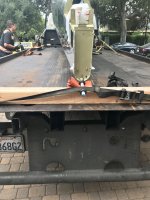New owner will be picking up my RV-8 fuselage (wings, tail, etc.) next week and plans on moving the entire kit in a 26' enclosed moving truck. The fuselage is on the standard gear (with no hubs/wheels) and standard tail hook (with standard tailwheel.)
Should the very aft portion of the fuselage be supported with foam blocks or is it fine for the standard tailwheel to be on the truck floor? I'm guessing the moving truck suspension will be very stiff with only several hundred pounds of wings, tails, fuse, etc.
Also the wings are currently in a cradle (the type with plywood airfoil shape and foam) not the type of cradle with fabric straps.
Any experiences of helping the kit arrive unscathed is greatly appreciated!
Thank you in advance,
Stan
Should the very aft portion of the fuselage be supported with foam blocks or is it fine for the standard tailwheel to be on the truck floor? I'm guessing the moving truck suspension will be very stiff with only several hundred pounds of wings, tails, fuse, etc.
Also the wings are currently in a cradle (the type with plywood airfoil shape and foam) not the type of cradle with fabric straps.
Any experiences of helping the kit arrive unscathed is greatly appreciated!
Thank you in advance,
Stan
Last edited:






